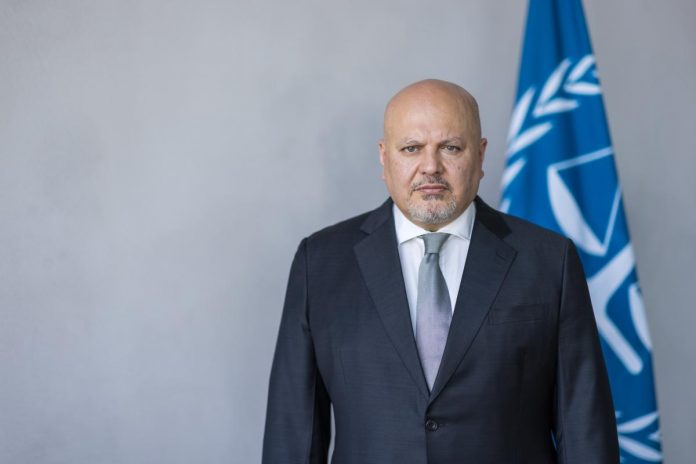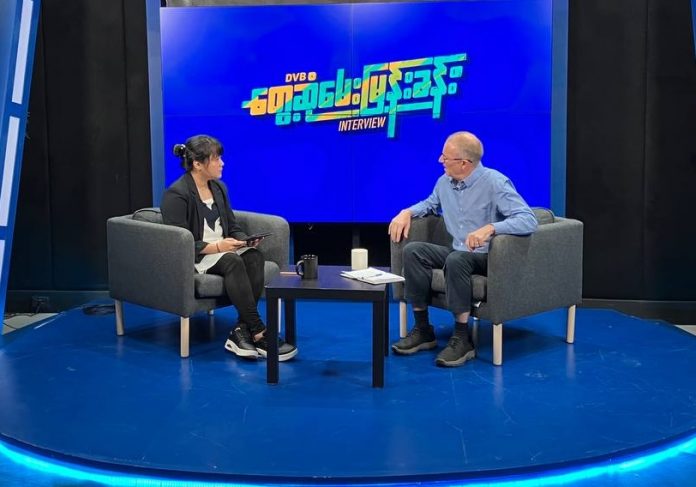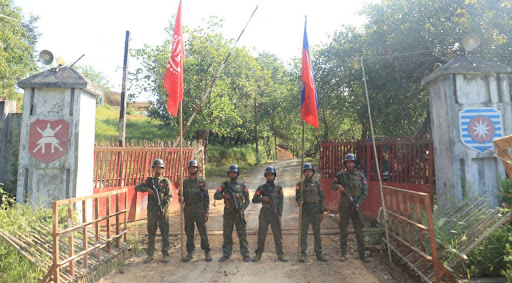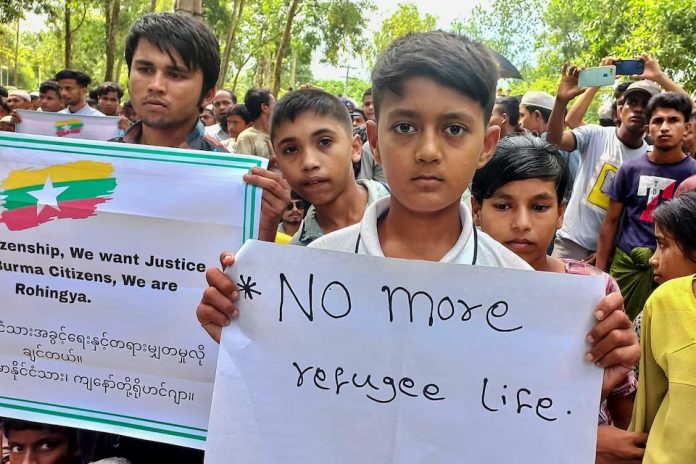An arrest warrant for Myanmar military general Min Aung Hlaing was requested by the International Criminal Court (ICC) on Nov. 27 by the ICC Chief Prosecutor over alleged crimes against humanity for the forced deportation of Rohingya from Myanmar into Bangladesh by the military in 2016-17. Read more here. And here for the international response.
International Criminal Court seeks arrest warrant for Min Aung Hlaing

Conflict, Complexity, Climate Change & COP29 in Myanmar

Ashley South, the author of Conflict, Complexity and Climate Change: Emergent federal systems and resilience in post-coup Myanmar, returned to the DVB newsroom to discuss the UN Climate Change Conference COP29 in Baku, Azerbaijan Nov. 11-22. He shared how nation states are beginning to take climate adaptation and mitigation seriously, except for Myanmar, which is one of the world’s most vulnerable countries to climate change. #myanmar
Arakan Army claims control over Taungup in southern Arakan State

The Arakan Army (AA) announced on Thursday that it had seized full control of Taungup town in southern Arakan State, which is located 284 miles (457 km) south of the state capital Sittwe, on Nov. 24.
“Efforts were made to evacuate local residents near the enemy’s [military] positions to minimize civilian casualties in order to ensure the local population would be safe from conflict zones,” the AA stated on Nov. 28.
It captured multiple military and government facilities, checkpoints, and a police station after it launched its offensive on Taungup Nov. 7. The AA added that it is attacking the No. 5 Military Operations Command Headquarters (MOC), outside of Taungup, along with the Light Infantry Battalions (LIB) 346 and 544, which fall under the command of the No. 5 MOC.
There are a total of three MOCs in Arakan State. The AA overran the No. 15 MOC in Buthidaung Township in May and the No. 9 MOC in Kyauktaw in February. The AA was accused of burning down over 7,500 homes and at least six mosques in Buthidaung, home to an estimated 260,000 Rohingya, before it seized the town on May 18.
Over the past few months, the AA has mostly shifted its offensive from northern Arakan to Ann, Taungup, and Gwa townships in the central and southern parts of the state. Ann town is 199 miles (320 km) southwest of Sittwe and is where the Western Regional Military Command (RMC) headquarters is based.
The AA has taken full control of 10 townships in Arakan State, as well as Paletwa Township in southern Chinland, since it launched its offensive on Nov. 13, 2023.
About 30 civilians have been reportedly killed during fighting in Taungup Township over the last six months. The AA did not report any casualties on Nov. 28, but claimed that an unknown number of civilian infrastructure was destroyed by military airstrikes and artillery attacks.
Min Aung Hlaing arrest warrant application welcomed; UK court fines company for importing teak from Myanmar

Min Aung Hlaing arrest warrant application by ICC welcomed
Messages of support have been coming in from all corners of the globe after the International Criminal Court (ICC) Chief Prosecutor Karim Khan announced that he was applying for an arrest warrant against regime leader Min Aung Hlaing at the ICC Pre-Trial Chamber 1 on Wednesday.
The arrest warrant application on Nov. 27 by the ICC Chief Prosecutor is over alleged crimes committed by Min Aung Hlaing when he ordered his Myanmar military into northern Arakan State to carry out a “security clearance” operation against the Rohingya in 2016-17. The ICC case refers to the subsequent mass deportation of Rohingya from Myanmar into Bangladesh as a crime against humanity.
“This is a day of celebration not just for Rohingya, but for everyone from Burma,” said Tun Khin, the president of Burmese Rohingya Organisation UK (BROUK). “This is not only about seeking justice and accountability, but also an acknowledgement of the crimes committed against us, which were ignored for so long.”
UK court fines company for importing teak from Myanmar
A U.K. court fined the British yacht builder Sunseeker International £358,760 ($454,118 USD) for importing teak from Burma after a hearing on Nov. 22, The Independent newspaper reported. Burma’s teak industry is a key source of revenue for the military regime, which seized power after the 2021 coup.
“Using blood teak from conflict-torn Myanmar is totally unacceptable and will cost them dearly in the end,” said Faith Doherty, the forests campaign leader of the U.K.-based Environmental Investigation Agency, which welcomed the court ruling as a “milestone” in combating the global illegal timber trade.
Sunseeker International claims it has taken steps to prevent future imports of teak from Burma. The U.K., the U.S. and the E.U. have imposed sanctions on the regime in Naypyidaw, and have made nearly all teak imports from Burma illegal. Beatrix, the former Queen of the Netherlands, was accused of using teak from Burma in renovating the deck of her luxury ship in 2023.

‘Kawthoolei Climate Action Plan’ presented at COP29
Ashley South, the author of Conflict, Complexity and Climate Change: Emergent federal systems and resilience in post-coup Myanmar, returned to the DVB newsroom to discuss the U.N. Climate Change Conference COP29 in Baku, Azerbaijan Nov. 11-22. He shared how nation states are beginning to take climate adaptation and mitigation seriously, except for Burma, which is one of the world’s most vulnerable countries to climate change.
“In Myanmar, where we have an illegal [regime] that is quite incapable of this work, I think that it really presents a strong opportunity to work with sub-national authorities, such as the Karen National Union, the Kachin Independence Organization, and then also state-level bodies,” said South. “My view is that there should be no international climate funds going anywhere near [Naypyidaw].”
South added that two environmental activists from Karen State attended COP29 to present a “Kawthoolei Climate Action Plan.” Out of 183 countries listed in the 2021 Global Climate Risk Index, Burma is ranked the second most vulnerable to extreme weather events. Stay tuned to DVB English News for the second Newsroom interview with Ashley South on conflict, complexity, and climate change in Burma.
News by Region
CHINLAND—Two members of the Chinland Defense Force (CDF) were killed and nine others were injured after the Chin National Army (CNA) seized control of a military outpost near the Chinland capital Hakha on Monday. Nearly 20 military personnel – out of the 0ver 30 stationed inside the outpost – have been injured by CNA-led resistance forces since fighting began on Nov. 22.
“The Burma Army was deployed there for two months,” Salai Htet Ni, the CNF spokesperson told DVB. The military outpost is located 22 miles (35 km) from Hakha on the road connecting it to Thantlang. It is mainly used for providing food and reinforcements to the military. CNA-led forces launched an offensive on outposts in Thantlang and Hakha in July.
KARENNI—The Karenni Army (KA) claimed that it killed nearly 30 military personnel during fighting near the Karenni State capital Loikaw on Nov. 25-26. It stated that regime troops fled an ambush it laid and that it wasn’t aware of any civilian casualties.
“Only around 20 troops from the battalion remained. [Its] commander was critically wounded and evacuated by air,” Phone Naing, the KA spokesperson told DVB. Retaliatory airstrikes were carried out near the site of the ambush. The KA seized ammunition and explosives from the military after the attack.
MANDALAY—Three civilians, including a novice Buddhist monk, were killed by a drone strike conducted by the military on Letkaunggyi Ywarthit village in Madaya Township, which is located 24 miles (39 km) north of the city of Mandalay, on Wednesday.
“A bomb dropped by the drone landed on a religious building in the monastery compound,” a Madaya People’s Defense Force (PDF) spokesperson told DVB. The regime has restricted telecommunication services in Madaya since the Mandalay PDF (MPDF) and the Ta’ang National Liberation Army (TNLA) launched a joint offensive in Mandalay Region and Shan State on June 25.
NAYPYIDAW—A resistance group calling itself the Kloud Drone Team claimed that it had conducted a drone strike on a wedding ceremony of the son of the chief of general staff of the military Maung Maung Aye, in Naypyidaw, on Monday, It added that an unknown number of people were killed or injured.
It stated that it had targeted the wedding due to intel gathered that there would be a presence of high-ranking regime officials at the ceremony. Kloud Drone Team claimed responsibility for drone strikes on Naypyidaw’s Ayelar Air Force base shortly after Min Aung Hlaing departed for China on Nov. 5.
(Exchange rate: $1 USD = 4,480 kyat)
Joy House on Thai-Myanmar border presents Joy Fest 2024

In Mae Sot, Thailand is Joy House, an arts and healing center, where the Thai and Myanmar communities can come together for cross-cultural exchange and educational opportunities. On Nov. 30, Joy House is hosting Joy Fest 2024, an online musical concert to raise funds for families displaced by violence and conflict in Myanmar.
Min Aung Hlaing arrest warrant application by International Criminal Court prosecutor welcomed
Messages of support have been coming in from all corners of the globe after the International Criminal Court (ICC) Chief Prosecutor Karim Khan announced that he was applying for an arrest warrant against regime leader Min Aung Hlaing at the ICC Pre-Trial Chamber 1 on Wednesday.
The arrest warrant application on Nov. 27 by the ICC Chief Prosecutor is over alleged crimes committed by Min Aung Hlaing when he ordered his Myanmar military into northern Arakan (Rakhine) State to carry out a “security clearance” operation against the Rohingya in 2016-17. The ICC case refers to the subsequent mass deportation of Rohingya from Myanmar into Bangladesh as a crime against humanity.
“This is a day of celebration not just for Rohingya, but for everyone from Burma,” said Tun Khin, the president of Burmese Rohingya Organisation UK (BROUK). “This is not only about seeking justice and accountability, but also an acknowledgement of the crimes committed against us, which were ignored for so long.”
Human Rights Watch released a statement in support of the potential Min Aung Hlaing arrest warrant for crimes against humanity after Khan’s announcement on Wednesday.
“The ICC prosecutor’s request for this arrest warrant is a strong warning to Myanmar’s abusive military leaders that they’re not beyond the reach of the law,” said Maria Elena Vignoli, the senior international justice counsel at Human Rights Watch. “And it sends the Rohingya community an important message that their struggle for justice has not been forgotten.”
Anna Roberts, the executive director at Burma Campaign UK, welcomed the news that Khan requested an arrest warrant for Min Aung Hlaing. She said that it was long overdue and that it would be supported by the people of Myanmar.
“For decades the Burmese military has been allowed to get away with violating international law without facing consequences. Justice is slowly closing in on the generals, but there is still a long way to go,” she added.
Myanmar’s civilian-led National Unity Government (NUG) – which was formed by ousted lawmakers, ethnic nationality leaders, and other opponents of the Feb. 1, 2021 military coup – welcomed the ICC announcement.
“It confirms what Myanmar’s people, particularly the Rohingya, have long known – that Min Aung Hlaing is criminally responsible for horrific, continuing atrocities,” Duwa Lashi La, the NUG Acting President, posted on social media.
The NUG has called for Min Aung Hlaing to be held accountable for his alleged crimes, including those committed after the 2021 coup. The regime in Naypyidaw, which seized power after the coup, stated that it does not acknowledge the ICC since Myanmar is not a signatory of the Rome Statute which established the court
Khan argues that while Myanmar is not an ICC member country, the exodus of Rohingya from Arakan State into Bangladesh – which is a signatory – means that an element of the crime is under ICC jurisdiction.
Khan added the application for the arrest warrant is only the first step and that more warrants will be requested for other high-level military officials in Myanmar.
In 2019, the ICC authorized a petition from its chief prosecutor’s office to investigate alleged crimes committed by the Myanmar military against the Rohingya. Thousands of Rohingya were killed in 2016-2017 and over 700,000 were forced to flee their homes across the border into Bangladesh, where they have been living in refugee camps ever since.
In 2022, the U.S. government labeled the 2017 attacks on the Rohingya as genocide.



